Raspberry Pi


how to
Create Your Own Ethical Hacking Kit with a Raspberry Pi 5


how to
Discover & Attack Raspberry Pis Using Default Credentials with Rpi-hunter


how to
How to Use a Raspberry Pi as a Dead Drop for Anonymous Offline Communication
Featured On Null Byte:
Cyber Weapons Lab










Featured On Null Byte:
Wi-Fi Hacking










Featured On Null Byte:
Password Cracking


























































































